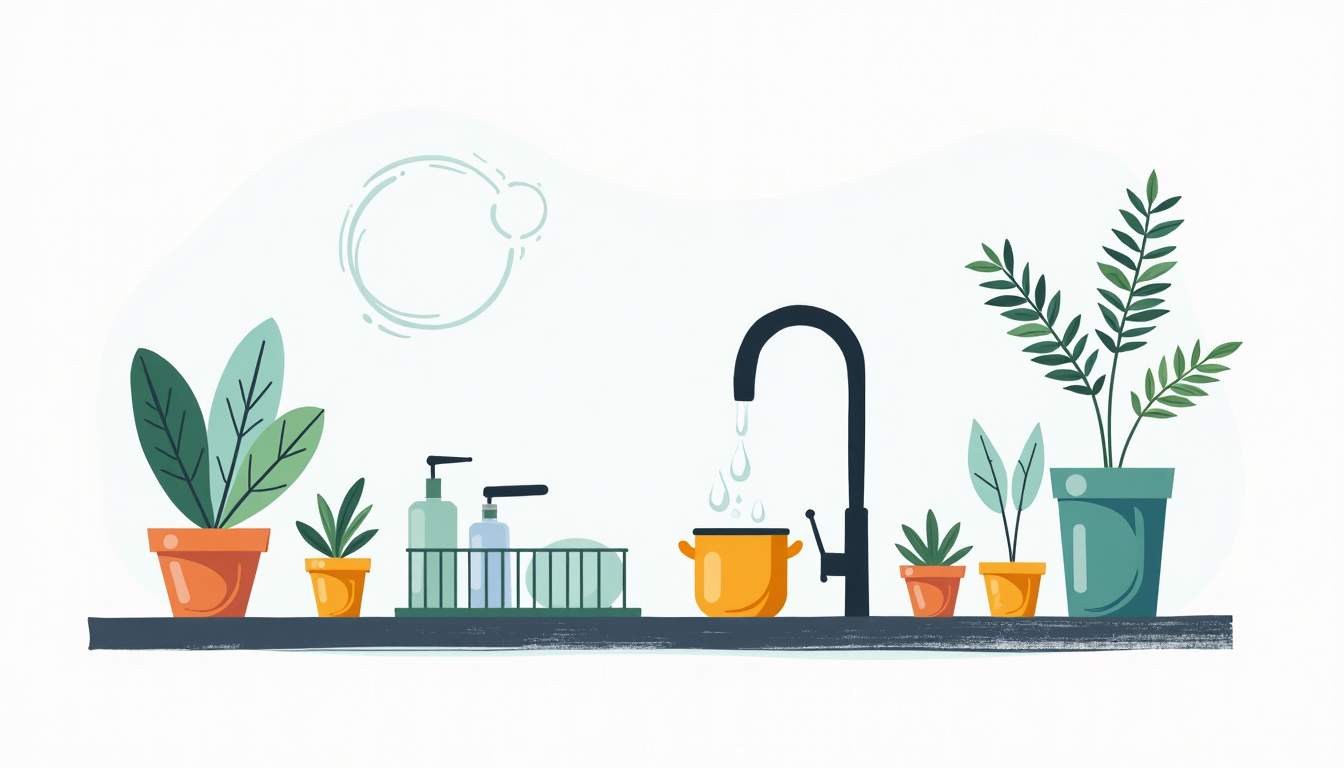Water is often thought of as a utility: something to drink, cook with, or flush away. But when days are arranged around the rhythms and qualities of water, life shifts. The rise and fall of a morning shower, the steady patter of rain against a window, the mindful pause of filling a glass—these small interactions can frame time, shape mood, and guide intention. This article explores practical and poetic ways to let water shape daily life so that routines become gentler, presence deepens, and days feel more fluid.
How a day begins sets its tone. Water can be the first architect of that mood. A deliberate approach to morning water—whether through a rinse, a beverage, or a moment with a houseplant—creates a bridge from sleep to wakefulness that is softer and more considered than jumping straight into tasks.

Start with a single, small habit. Rinse the face with cool water before the phone is touched. Let the splash be the signal that the body is present and the mind is still allowed a margin of calm. Alternatively, extend the moment: savor the steam from a hot shower or the warmth from a wet towel around the neck. These small rituals reduce the rush and signal a gentle beginning.
Drinking a glass of water upon waking is not merely a physiological reset; it can be an act of care. Placing the glass in a visible, habitual location turns hydration into an expected part of the morning choreography. The choice of vessel—weighty ceramic mug versus clear glass—can make the act feel either grounding or transparent, both of which shape the start of the day differently.
Water’s movement offers a model for productive attention. Workdays that mimic usable qualities of water—flow, breaks, direction—tend to sustain concentration and reduce resistance. The idea is not to be constantly busy but to find a rhythm where energy moves purposefully, then refreshes.
Break work into manageable segments and punctuate them with brief water-related pauses. A five-minute break to refill a bottle, wash a cup, or simply stand by the window and watch rain is a micro-reset. Those pauses serve like eddies in a stream: they slow momentum just enough to keep the current from wearing out its banks.
Ambient water sounds—distant rain, a fountain, low-flow white noise—help maintain a steady cognitive background. These sounds reduce startle reactions to sudden noises and create a predictable acoustic environment that supports sustained attention. For those who work in noisy spaces, a short loop of gentle water sound can be surprisingly stabilizing.
Water shapes eating habits and mealtime presence in tactile ways. The act of pouring, stirring, and sipping can reintroduce slowness to meals. When utensils and dishware are treated as part of an aquatic choreography, eating becomes less incidental and more nourishing in both taste and intention.
Presenting drinks—tea, infused water, a simple glass of ice—creates a moment of attention around nourishment. Pouring water into a pitcher with slices of fruit or herbs transforms hydration into a sensory event. The temperature, the condensation on the glass, the clink of ice: small details tether the mind to the immediate pleasure of being fed and cooled.
Pace meals to allow water to function as a reset between bites. Small sips between forkfuls quiet the rush to swallow and heighten awareness of texture and flavor. This practice supports digestion and prevents overeating by slowing consumption and preserving satiety cues.
Water’s shape informs how the body moves and repairs. Swimming is the obvious aquatic activity, but even land-based routines can borrow water’s principles: movements that are smooth, expansive, and balanced. Recovery rituals that involve water—baths, compresses, cool showers—speed recuperation and signal a safe return to ease.
Consider exercises that emphasize range of motion and flow: yoga sequences that move like tides, tai chi that mimics currents, or mobility work that smooths joints through slow arcs. These movements encourage continuity rather than staccato effort, reducing strain while building sustainable strength and flexibility.
Contrast showers—alternating warm and cool—stimulate circulation and provide a quick, accessible recovery method. Epsom salt baths remain a reliable way to relax sore muscles, while simple foot soaks with a few drops of essential oil are especially restorative after long days on the feet. These practices aren’t indulgent extras; they are efficient tools to reset the nervous system.
Natural bodies of water have a profound way of modulating mood. Exposure to lakes, rivers, or the sea recalibrates perception and reduces the clutter of daily anxieties. Even urban water features—canals, fountains, rain-soaked streets—offer a break from the constant stimulation of modern life.
A thirty-minute walk along a riverbank or a brief pause on a dock shifts perspective. The scale of water, its permanence and motion, reveals problems to be smaller and time to be larger. Regular exposure to these environments makes the mind more tolerant of uncertainty and better at processing emotional complexity.
For those without easy access to natural water, indoor solutions exist. Houseplants with glossy leaves, tabletop fountains, or even a carefully curated playlist of wave and rain recordings provide similar soothing cues. These substitutes recreate the visual and auditory hallmarks of water—reflectivity, motion, repetition—so the calming benefits remain within reach.
Treating water as precious reshapes household habits. Conserving without sacrificing comfort instills a mindful orientation toward resources. Simple shifts reduce waste, save money, and make living spaces more intentional and efficient.

Installing a low-flow showerhead, fixing leaky faucets promptly, and timing showers intentionally can cut household water use significantly. Laundry loads that are full and dishes that are washed mindfully—rather than on autopilot—ensure water is used with purpose. These adjustments encourage a relationship of respect rather than taking consumption for granted.
Design elements can nudge sustainable behavior: a visible water pitcher on the counter encourages refilling rather than buying bottles; a shower timer or a light that indicates long showers prompts awareness without policing. Thoughtful architecture, such as greywater systems or rain barrels, brings conservation into daily life rather than relegating it to occasional concern.
Water can bookend the day as effectively as it begins it. Evening routines centered on water create a sense of completion. A warm shower can wipe away the day’s residue; hydration before bed ensures better sleep; dim lights reflecting on still water offer a visual cue for winding down.
A short soak with calming scents—lavender, chamomile—signals the nervous system to transition. Even when time is limited, a few minutes letting warm water run over the shoulders or soaking the feet in a basin has a disproportionate calming effect. These acts reframe sleep not as an escape but as a valued practice of renewal.
Hydration in the evening should be balanced: enough to prevent thirst through the night, but not so much that sleep is interrupted by bathroom trips. Sipping herbal teas or taking a small glass of room-temperature water before bed supports both comfort and sleep architecture, especially when paired with a consistent pre-sleep ritual.
Water models a tempo that is neither frantic nor stagnant. It finds channels, respects obstacles, and persists. Allowing days to be shaped by water is a choice to lean into patience, to favor smooth adjustments over forced acceleration, and to welcome the small, steady returns that build resilience.
Start by noticing where days speed up unnaturally and where they stall. Introduce a water-inspired cadence: fluid transitions, brief pauses, and restorative dips. Over time, these adjustments change how time is experienced. Tasks become parts of a larger, moving whole rather than discrete crises demanding immediate attention.
Shared water rituals—teatime, communal meals with pitchers at the center, walks beside rivers—bring people into a common rhythm. These moments are not just social; they recalibrate group tempo, encouraging conversations that unfold at a measured pace and relationships that deepen through repeated, low-pressure encounters.
Water offers a template for living that is adaptable, patient, and renewing. Letting it shape days is not about rigid ritualizing but about choosing gestures that remind the body and mind to move with grace. Through small habits—savoring a morning glass, structuring work with micro-pauses, using baths for recovery—the ordinary becomes a practice of presence. In doing so, time stops feeling like something to conquer and starts feeling like an element to navigate.

When water is invited to define smaller moments, days shift from a series of friction points to a gentle current carrying life forward. The invitation is simple: tune attention to water’s qualities and let them guide the tempo of each day. Over time, the smallest of pours will be found to have the largest effects.
Embrace a lifestyle where water’s calming presence and natural rhythms shape your days, just as Tennessee National shapes an exceptional living experience. From our serene waterfront dining and private marina to scenic nature trails and a Greg Norman Signature Golf Course, every detail invites you to live with ease and grace. Discover your perfect home in our premier gated community and let each day flow with comfort and elegance. Schedule a Private Tour today and start making memories that move with the gentle current of Tennessee National.